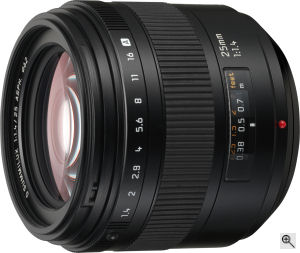 PRESS RELEASE: Sales Under Way of the Second Leica Lens Designed Specifically for the Digital SLR camera.
PRESS RELEASE: Sales Under Way of the Second Leica Lens Designed Specifically for the Digital SLR camera.
Panasonic today introduced the second Leica interchangeable lens designed specifically for the digital SLR camera. The LEICA D SUMMILUX 25mm/F1.4 ASPH. complies with the Four Thirds System and will be available by April.
The new LEICA D SUMMILUX 25mm/F1.4 lens (35mm equivalent: 50mm) is a bright, large-diameter F1.4 standard lens. It incorporates an aperture ring and boasts as many as 10 lens elements in 9 groups, including a large-diameter aspherical lens, which assure a superb optical performance and F1.4 brightness, while one super ED (extra-low dispersion) lens and three ED lenses reduce color bleeding to an absolute minimum. LEICA D SUMMILUX 25mm/F1.4

Bright, large-diameter F1.4 25mm fixed focal length lens (35mm equivalent:50mm)
A large total of 10 lens elements in 9 groups, including a large-diameter aspherical lens, give this bright, standard F1.4 lens a superb optical performance. A large-diameter front lens ensures sufficient peripheral light levels, and a large-diameter front aspherical lens reduces light degradation all the way to the lens periphery. The result is high resolution and absolutely minimum lens distortion.
One super ED lens and three ED lenses
Four extra-low dispersion lenses suppress chromatic aberration, thus minimizing color bleeding.
Aperture ring with a familiar, intuitive touch
When the D SUMMILUX lens is used with the LUMIX DMC-L1 digital camera, the user has an aperture ring as well as a focus ring at his or her fingertips. These rings provide the same kind of easy, pleasant, intuitive operation people enjoy with the familiar film camera.
Minimum photographic distance of 38 cm for beautiful macro shooting
Unlike the 50mm lenses used on conventional 35mm film cameras, the D SUMMILUX lens uses a floating focus that reduces minimum photographic distance to just 38 cm. In addition to the lens's high optical performance and low aberration, maximum photographic magnification of 0.17x (35mm equivalent), which combines with the F1.4 brightness allows beautiful macro shooting.
Circular aperture diaphragm
Seven aperture blades create a rounded shape. This combines with the F1.4 brightness to produce a beautiful smoothness in out-of-focus areas at larger aperture.
Multiple lens coatings minimize ghosts and flare
Multi-coated lenses reduce ghosts and flare to an absolute minimum, helping the D SUMMILUX deliver an optical performance that meets Leica's lofty standards.
SPECIFICATIONS | LEICA D SUMMILUX 25mm/F1.4 ASPH. | | Lens Construction | 10 elements in 9 groups (1 aspherical lens, 1 Super ED lens and 3 ED lenses) | | Mount | Four Thirds mount | | Focal length | f=25mm (35mm film camera equiv. 50mm) | | MEGA O.I.S. (Optical Image Stabilizer) | No | | Aperture type | 7 diaphragm blades / Iris diaphragm | | Minimum aperture | F16 | | Closest focusing distance | 0.38m | | Maximum magnification | Approx. 0.17x (35mm film camera equivalent) | | Diagonal angle of view | 47 degrees | | Filter size | 62mm | | Dimensions (Diameter x Length) | 75mm | | Weight | Approx. 510g | # # #(Editor's note: This lens was first announced back on September 26, 2006 at Photokina. Here's a link to the original press release, for your convenience.)
(First posted on Sunday, March 11, 2007 at 00:31 EST)
|